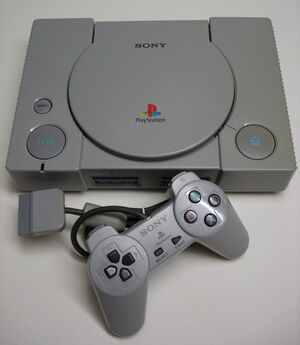|
PlayStation
| |
|
Manufacturer
|
Sony Computer Entertainment
|
|
Type
|
Video game console
|
|
Generation
|
Fifth generation
|
|
Retail availability
|
PlayStation
December 3, 1994 (Japan) September 9, 1995 (North America) September 29, 1995 (Europe) November 15, 1995 (Australia) 1996 (Korea) PSone July 7, 2000 (Japan) September 19, 2000 (North America) September 29, 2000 (Europe) |
|
Discontinued
|
PlayStation: March 23, 2006
PSone: March 23, 2006 |
|
Units sold
|
Worldwide: 102.49 million
|
|
Media
|
CD-ROM
|
|
CPU
|
MIPS R3000A-family R3051
33.8688 MHz
|
|
Successor
|
|
The PlayStation was the first video game console released by Sony. Released in 1994 as part of the fifth generation of gaming, it competed primarily against the Nintendo 64 and the Sega Saturn as well as the 3DO and Atari Jaguar.
The console was originally conceived as a CD add-on for Nintendo's SNES (similar to the Sega CD for the Genesis), but the deal between Sony and Nintendo fell through for various reasons. This led to the creation of the PlayStation console as well as a brief but dismal collaboration between Nintendo and Philips.
The CD based console was highly successful, credited as the first "computer entertainment platform" to ship 100 million units. The system debuted many successful franchises, including Resident Evil, Klonoa, Crash Bandicoot, Spyro and Silent Hill, and was followed up by the PlayStation 2 in 2000, the PlayStation 3 in 2006 and the PlayStation 4 in 2013.
Hardware problems[]
With the early units, particularly the early 100x models, many gamers experienced skipping full-motion video or physical "ticking" noises coming from their PlayStations. The problem appears to have come from poorly placed vents leading to overheating in some environments—the plastic moldings inside the console would warp very slightly and create knock-on effects with the laser assembly. The solution was to ensure the console sat on a surface which dissipated heat efficiently in a well vented area, or raise the unit up slightly by propping something at its edges. A common fix for already affected consoles was to turn the PlayStation sideways or upside-down (thereby using gravity to cancel the effects of the warped interior).
The first batch of PlayStations used a KSM-440AAM laser unit whose case and all movable parts were completely made out of plastic. Over time, friction caused the plastic tray to wear out—usually unevenly. The placement of the laser unit close to the power supply accelerated wear because of the additional heat, which made the plastic even more vulnerable to friction. Eventually, the tray would become so worn that the laser no longer pointed directly at the CD and games would no longer load. Sony eventually fixed the problem by making the tray out of die-cast metal and placing the laser unit slightly farther away from the power supply on later models of the PlayStation.
Copy protection[]
Prior to the PlayStation, the reproduction of copyrighted material for gaming consoles was restricted to either enthusiasts with exceptional technical ability, or others that had access to CD manufacturers. However, the increased availability of cheap CD burners at this time led Sony to introduce a special wobble pressed into PlayStation formatted discs. As a result any discs that did not contain the wobble such as CD-R copies or standard pirated discs could not boot on the console.
The installation of a modchip allowed the PlayStation to play games recorded on a regular CD-R. It also allowed the console's capabilities to be expanded in other ways, such as playing games from other regions. By the end of the system's life cycle almost anyone with minimal soldering experience was able to perform these modifications. This created a wave of games developed without official approval using free, unofficial tools, as well as the reproduction of original discs. With the introduction of such devices the console became very attractive to programmers and illegal copiers alike, as well as those who merely wished to protect the lifespan of their lawful, original discs.
Some companies (notably Datel) did manage to produce discs that booted on unmodified retail units while using special equipment.
Models[]
The PlayStation went through a number of variants during its production run. From an external perspective, the most notable change between variants was the reduction in the number of connectors. The RCA jacks were removed in the first revision, and the Parallel I/O port was removed in the final revision.
On July 7, 2000, Sony released the PSone, a smaller, redesigned version of the original PlayStation. It was the highest-selling console through the end of the year, even outselling its successor, the PlayStation 2, which debuted a few months earlier. A version of the PSone included a 5-inch (130 mm) LCD screen, referred to as the "Combo pack".
In 1997, Sony marketed a development kit for hobbyists also known as the Net Yaroze. The development console came with the necessary documentation and software to program PlayStation games and applications.


